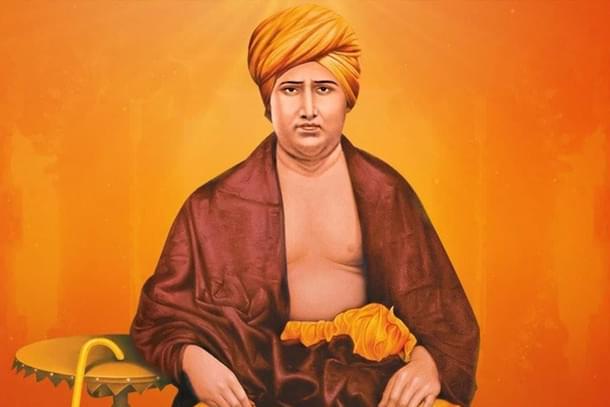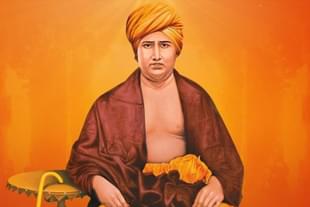Culture
Why We Need To Remember And Celebrate The Legacy Of Maharishi Dayanand Saraswati
Aravindan Neelakandan
Feb 17, 2023, 08:40 PM | Updated 08:40 PM IST
Save & read from anywhere!
Bookmark stories for easy access on any device or the Swarajya app.


Twelfth of February is an important day because two hundred years ago, Swami Dayananda Saraswati, the founder of Arya Samaj, was born on that day.
And 15 years before him on that day, was born Charles Darwin. Darwin published his Origin of Species in 1859 and Maharishi Dayananda published his Satyartha Prakash in 1875 (and republished it revised in 1883).
In a way the two books are alike and in a way, no two books can be more different. While Dayananda Saraswati has been often criticised for trying create a monotheism out of a Vedic fundamentalism, Darwin whispered to his close circle that the Godless evolution was for him like ‘confessing to murder.’
That said, both the books liberated humanity from ignorance. It is now well established in scientific domain what we owe Charles Darwin. But more often than not we forget what we owe Maharishi Dayananda.
Of course if one takes the literal meaning of the text then the criticism of Maharishi Dayananda forging a monotheism out of a literal interpretation of Vedas might sound right or wrong. But with seers like Swami Dayananda one cannot make one’s own puny judgements based on the tyranny of literal text. The Maharishi should be seen in the context of his historical times and understood from the evolutionary path through which the Indian nation progressed.
When the entire Vedic tradition seemed to be drowned in the chaotic ocean of social stagnation and hidden into obscurity of birth-based system, Swami Dayananda came, plunged into the cruelly roaring waves of social stagnation and brought out the Vedas. When Vedic grandeur of this civilisation was fossilised by some pseudo-traditionalists and when colonialists tried to justify themselves by using the same traditionalists, Swami Dayananda stood for reason and socio-spiritual upliftment of the downtrodden and women.
His rejection of the ‘idol’ wordship and Puranas should be seen in this context and in this context alone. The Arya Samaj spearheaded mass institutional education. It pioneered female education. British administrators keenly observing Arya Samaj movement were alarmed.
Herbert Butler was one such. As Lieutenant Governor of Oudh and North West Provinces, he had praised the Arya Samaj contribution to education and famine relief work in public; but in a private letter to Sir James Dunlop he cautioned and urged thus:
What will be the end of the Arya Somaj (sic)? What will be the upshot of female education? If the Government is not quick it will find the women of India educated by Arya Somajists (sic). Now is the time, it seems to me, to get out ladies from England in numbers as Inspectresses and teachers to guide female education. ... To me that our position in the country will be almost hopeless, if the women are trained up in hostility to us. The Arya Somaj is a dangerous movement because it combines an appeal to national feeling with a tendency to elevate the low castes. Shivaji did this. So has every great Hindu leader.... They swept in new forces by promoting the low castes to be Rajputs and Brahmans.
Butler had made the correct civilisational connection here and hence he understood the danger the movement posed to colonial presence.
This Rashtra and Dharma have always been protected by spiritual emancipators of the society and not by status-quoists.
Today there may be critics of Maharishi Dayanand who would judge him by the feminist of today. To them nothing can provide better perspective than what Yuval Noah Harari writes in Homo Deus about Maharishi Dayanand— that he‘often interpreted the Vedas in a surprisingly liberal way, supporting for example equal rights for women long before the idea became popular in the West’ while also pointing out that the views on women of his contemporary Pope Pius IX were much conservative compared to that of Maharishi.
Arya Samajists fought against caste injustice equally. And what a brave fight that was!
A case in point is the Dola-Palki resistance movement of Shilpakaras of Uttarakhand hills.
The question was for the right of the scheduled community of the region who were occupationally artisans. Islamists and ‘upper caste’ Hindus joined hands to attack the Shilpakar community, taking their bride and bridegroom during a marriage ceremonial procession.
The Arya Samaj took up the cause and proactively made a forward linkage of this local struggle for social justice with the larger national movement.
Arya workers got Gandhi involved. All these activities, with painful suffering on the part of Aryas nevertheless dragged the society out of its Tamasic adherence to birth-based social stratification. It also prevented conversion, (had it happened, it would be justifiable) to Christianity. And this was just one example.
The famine relief work of Arya Samaj in Punjab saved the lives and souls of many afflicted by famines. The colonial government not only inflicted famines upon India but also created the narrative that it was the Hindu fatalism that was responsible for it.
Then through a fraction of the surplus of colonial resource piracy and with institutional support, the missionaries would 'harvest soul' using famine relief. It was in such a situation that Arya Samaj reached out to famine affected regions and did an extraordinary, almost superhuman service for humanity.
Modern-day criticism of Arya Samaj
Today, it has become fashionable for neo-traditionalists of the internet variety to create posters and memes attacking Maharishi Dayananda. But they would not even exist had there been no Arya Samaj.
Arya Samaj became the resistance movement and renaissance movement combined into one.
From the fiery womb of Arya Samaj came Lala Lajpat Rai, Bhai Paramanand and Swami Shradhanand. They played an important role in preventing conversions and bringing back the lost. The Shuddhi ritual Arya Samaj created has become an important shield and armour in the hands of the Hindu movement.
One may not agree with each and every word of Maharishi Dayanand, but he revitalised India.
Perhaps nothing can do more justice to the sacred living memory of this Vedic Maharishi of modern times than the words of Mahayogi Sri Aurobindo, which need to be quoted in length to bring out the greatness of Maharishi Dayanand:
To be national is not to stand still. Rather, to seize on a vital thing out of the past and throw it into the stream of modern life, is really the most powerful means of renovation and new-creation. Dayananda’s work brings back such a principle and spirit of the past to vivify a modern mould. ...Practical truth, arjava, an inner candour and a strong sincerity, clearness and open honour in the word and deed, was the temperament of the old Aryan morals.
And again concluding the second essay on Maharishi Dayanand, Mahayogi Sri Aurobindo wrote:
In the matter of Vedic interpretation I am convinced that whatever may be the final complete interpretation, Dayananda will be honoured as the first discoverer of the right clues. Amidst the chaos and obscurity of old ignorance and age-long misunderstanding his was the eye of direct vision that pierced to the truth and fastened on that which was essential. He has found the keys of the doors that time had closed and rent asunder the seals of the imprisoned fountains.Vedic magazine, 1915
Aravindan is a contributing editor at Swarajya.





